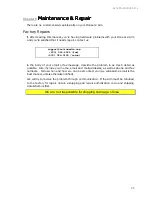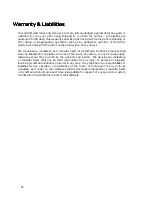
Arm FLASH Parameters
20
Table 7. p2oscf startup options
Argument
Description
-h
List p2oscf argument options and quit
-b
Batch
mode;
series
configuration
command
must
follow.
Configuration changes made to FLASH parameters
-n
Operate
p2oscf
without
connecting
with
the
microcontroller.
Useful for editing parameter files saved to disk.
-p
Set
serial
port;
serial
port
name
must
follow
immediately
after
argument; /dev/ttyS1 or COM3, for example.
-s
Automatically
save
changes
to
disk
file
named
in
path
immediately following argument.
Step 5: Changing Configuration Parameters
Normally when it starts,
p2oscf
automatically retrieves the current identifying and
operating parameters from your Pioneer 2 or PeopleBot robot. Some of the parameters,
"Constants", are not to be changed. The others, "Variables", including the Pioneer 2 Arm
parameters, are the ones that you may edit with
p2oscf
.
When working with
p2oscf
, you edit a temporary copy of the parameters list on your PC.
Your changes are not committed to your robot’s FLASH memory until you choose to
explicitly "
save
" them.
Step 6: Save Your Work
Use the
save
command to save configuration changes to your robot’s FLASH. If you
don’t save your changes to FLASH, they won’t take effect.
We also strongly recommend that you save your work to disk, as well, for later retrieval
should your microcontroller get damaged or it’s FLASH inadvertently erased. To save
your current configuration to a disk file, simply specify a path and filename with the save
command. For example:
save C:\p2os\myP2DX
copies the changes you’ve made on the PC to a disk file. Be careful: this does not
download the changes to your robot’s FLASH. Use
save
alone to do that.
Use the p2oscf
restore
command to not only retrieve the current operating parameters
from the robot, but to load a saved parameters files from disk. The P2OS distributions
come with common configuration files for the all
Activ
Media robot models, including
p2de for the Pioneer 2-DXE, p2at for the Pioneer 2-AT, and so on.
You may edit the file-restored parameters just as you edit those retrieved from the robot.
And you may save those edited parameters over the same file or a different one, using
the p2oscf
save
command.
Note that file-restored configuration parameters are not necessarily the same as those
stored in the robot's FLASH. You must
save
them there separately. Default parameter
files come with each P2OS distribution, but it is tedious to reconstruct an individual robot’s
unique configuration.








































